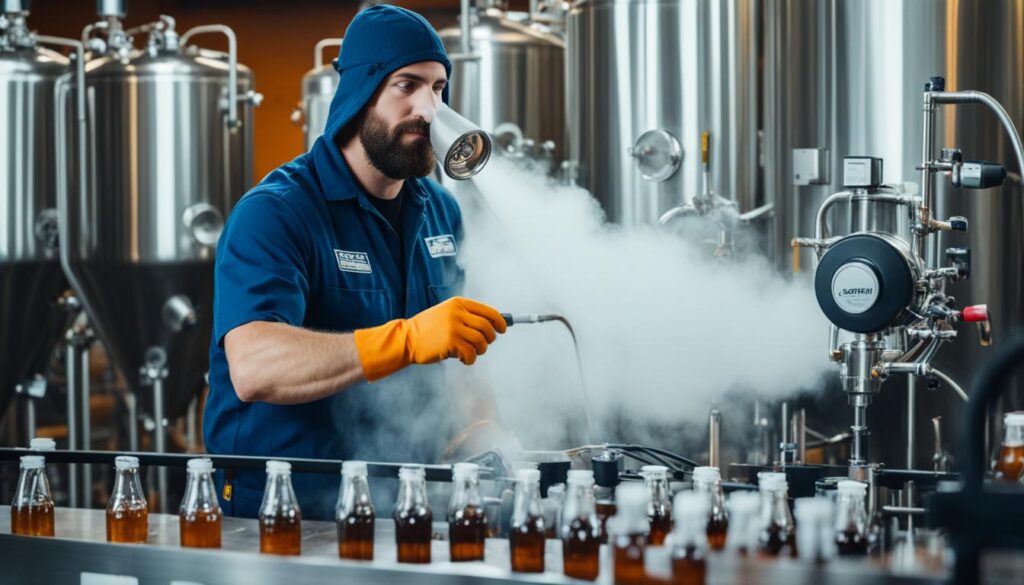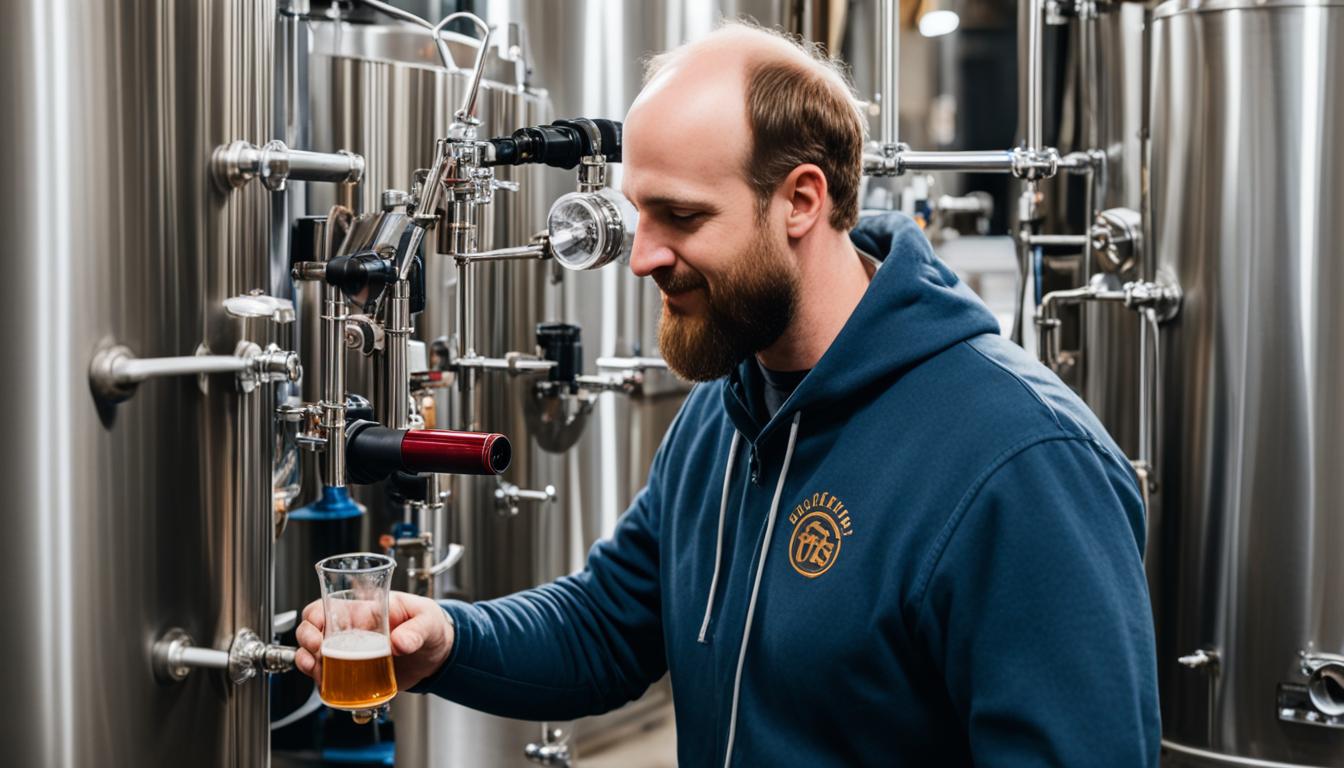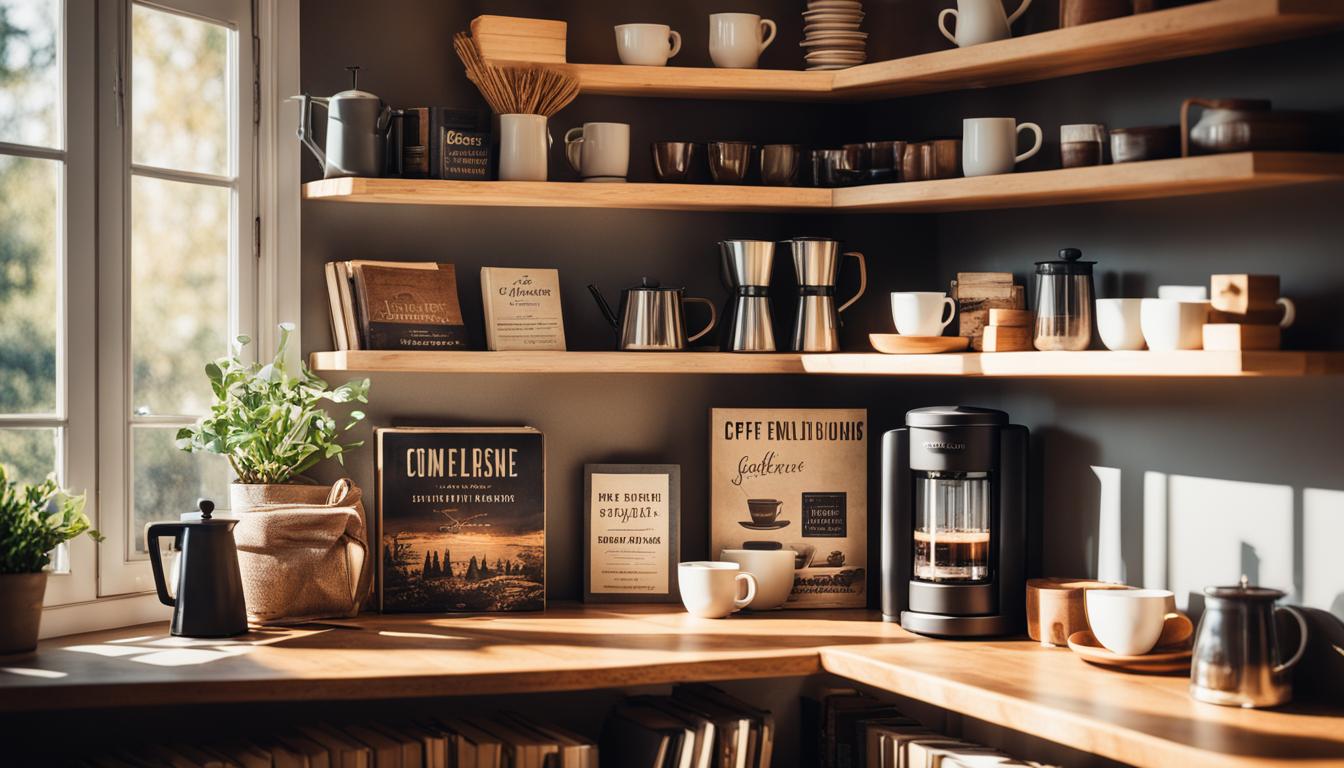Welcome, homebrewing enthusiasts! Whether you’re a seasoned homebrewer or just starting out on your brewing journey, we’re here to help you take your craft to the next level. In this guide, we’ll introduce you to the exciting world of advanced home brewing techniques, where you can unleash your creativity and brew exceptional craft beers.
Are you ready to unlock the secrets of advanced brewing methods and elevate your creations? Let’s dive in and discover the artistry behind crafting specialty beers that will impress your friends and family.
Key Takeaways:
- Learn advanced fermentation methods to optimize the flavors and aromas of your beer.
- Develop your own unique homebrew recipes that reflect your personal taste and style.
- Enhance the aromas and flavors of your brews with advanced techniques.
- Master the art of aging and conditioning your beer to perfection.
- Get expert advice on troubleshooting common issues in advanced brewing.
Understanding Advanced Fermentation Methods
Dive into the world of advanced fermentation methods and learn how to optimize the flavors and aromas of your beer. To truly master the art of home brewing, it is essential to understand the importance of fermentation. This crucial stage of the brewing process is where the magic happens, as the yeast converts sugars into alcohol and carbon dioxide, giving your beer its unique characteristics.
When it comes to advanced fermentation methods, precise temperature control and yeast management are key. By fine-tuning these variables, you can unleash a new world of flavor possibilities and achieve consistent results with each batch.
Temperature control during fermentation plays a vital role in shaping the flavor profile of your beer. Different styles of beer require specific temperature ranges to bring out their best qualities. Whether you’re aiming for a crisp and refreshing lager or a complex and aromatic ale, understanding the ideal fermentation temperature is crucial. Our experts will guide you through the optimal temperature range for various beer styles, enabling you to create brews that are true to their intended character.
Yeast management is another essential aspect of advanced fermentation techniques. The choice of yeast strain, pitching rates, and fermentation nutrients can greatly impact the final flavor and aroma of your beer. We’ll delve into the world of yeast and provide insights on selecting the right strain for your desired beer style, as well as tips on proper yeast propagation and management.
To further enhance your understanding of advanced fermentation methods, let’s consider some specific techniques:
- 1. Open Fermentation: Explore the unique characteristics that open fermentation can bring to your beer, including enhanced ester and phenolic profiles. Discover the process and benefits of this traditional method.
- 2. Pressure Fermentation: Learn how to ferment under pressure and take advantage of this technique to achieve cleaner flavors and quicker maturation.
- 3. Brettanomyces Fermentation: Delve into the fascinating world of Brettanomyces, a wild yeast strain that can add complex flavors and aromas to your brew.
To help you visualize the different fermentation methods and techniques, below is a table showcasing their key characteristics:
| Technique | Description | Benefits |
|---|---|---|
| Open Fermentation | Allows exposure to airborne yeasts and bacteria, resulting in unique flavor profiles | Enhanced ester and phenolic production, greater complexity |
| Pressure Fermentation | Fermenting under pressure to control off-flavors and reduce maturation time | Cleaner flavors, faster beer production |
| Brettanomyces Fermentation | Using Brettanomyces yeast strain for unique flavors and aromas | Complexity, funkiness, and fruity character |
Now that you have a solid understanding of advanced fermentation methods, you’re ready to unlock the true potential of your home brewing endeavors. Stay tuned as we dive deeper into the world of craft beer brewing with a focus on recipe development in the next section.
Developing Your Own Homebrew Recipe
Are you ready to unleash your creativity and showcase your brewing prowess? In this section, we will dive into the art of homebrew recipe development and guide you through the process of crafting your very own specialty beers. With these advanced beer brewing skills, you can break free from traditional recipes and create brews that reflect your unique taste and style.
Developing a homebrew recipe is both a science and an art. It requires a deep understanding of ingredients, a flair for creativity, and an adventurous spirit. Let’s explore the key steps involved in creating a homebrew recipe that will leave your friends and family in awe.
Ingredient Selection and Exploration
Building the foundation of a great beer begins with carefully selecting the right ingredients. From malt and hops to yeast and adjuncts, each component plays a crucial role in the final product. Take the time to explore different varieties and experiment with unique flavors.
“The beauty of homebrewing lies in the endless possibilities. Don’t be afraid to push boundaries and try out unconventional ingredients. Let your taste buds guide you.”
When selecting ingredients, consider the style of beer you want to create and the specific flavor profiles you aim to achieve. Whether you’re aiming for a hop-forward IPA, a malty stout, or a crisp lager, each ingredient should contribute to the overall character of the brew.
Recipe Formulation and Balancing Flavors
Creating a successful homebrew recipe requires a delicate balance of flavors. Take notes from your favorite commercial beers or seek inspiration from award-winning recipes. Begin by formulating a basic recipe that outlines the malt bill, hop schedule, and desired yeast characteristics.
Experiment with different malt combinations to achieve the desired color, body, and sweetness. Consider the alpha acid content of hops and the aroma profiles they bring to the table. And don’t forget to pay attention to yeast strains and fermentation temperature, as they greatly influence the final outcome of your beer.
Recording and Iterating
As an aspiring brewmaster, it’s essential to keep a detailed record of your recipe development process. Document each ingredient, the specific amounts used, and the brewing parameters. This not only helps you recreate successful brews but also allows you to iterate and improve your recipes over time.
Keep a brewing journal or use one of the many available brewing software applications to organize your notes. Analyze each batch, take note of the flavors, aromas, and any adjustments you’d like to make in the future. Remember, brewing is a continuous learning process, and each batch brings you closer to perfection.
| Ingredient | Amount | Role |
|---|---|---|
| Pale Malt | 8 lbs | Base malt for flavor and fermentable sugars |
| Cascade Hops | 1 oz (60 min), 1 oz (10 min), 1 oz (0 min) | Provides bitterness, flavor, and aroma |
| Citrus Peel | 1 oz (5 min) | Adds a refreshing citrus aroma |
| American Ale Yeast | 1 pack | Ferments sugars into alcohol and contributes to flavor |
Remember, creating your own homebrew recipe is an ongoing process of experimentation, refinement, and creativity. Embrace the challenge with enthusiasm and let your imagination run wild. Happy brewing!
Enhancing Aromas and Flavors with Advanced Techniques
Unlock the secrets to enhancing aromas and flavors in your homebrewed beer. At the advanced level of home brewing, you have the opportunity to experiment with specialty beer making secrets and Advanced Home Brewing Techniques that will take your brews to new heights of complexity and taste.
One technique to enhance the aroma of your beer is through dry hopping. This involves adding hops directly to the fermenter after primary fermentation. The hops impart unique aromas and flavors without contributing excessive bitterness.
Experimenting with different types of malt can also lead to exciting flavor variations in your beer. Try using specialty malts such as caramel or roasted malts to add depth and complexity. Each malt imparts its own distinct aroma and flavor characteristics, allowing you to create unique and memorable brews.
In addition, consider using adjuncts to add complexity to your beer. Adjuncts are non-traditional ingredients used in brewing, such as fruits, spices, or even coffee. These can provide additional layers of aroma and flavor, transforming your beer into something truly special.
Remember, each ingredient you add to your beer has the potential to enhance or detract from the final product. So, be sure to experiment in small batches and take careful notes on the results. This way, you can refine your techniques and create truly exceptional brews.
By incorporating these advanced techniques into your home brewing process, you’ll be able to unlock a world of flavor possibilities. Whether you’re looking to create a hop-forward IPA bursting with tropical aromas or a rich, malty stout with notes of chocolate and coffee, the secrets of specialty beer making and Advanced Home Brewing Techniques are within your reach.

What’s Next?
Next, we’ll delve into the art of aging and conditioning your beer. In Section 5, we’ll explore techniques such as barrel aging, bottle conditioning, and keg conditioning that will allow you to further enhance the flavors and textures of your brews.
Mastering the Art of Aging and Conditioning
When it comes to crafting exceptional beers, aging and conditioning play a crucial role in elevating flavors and achieving the optimal texture. In this section, we’ll explore advanced home brewing techniques for aging and conditioning, including barrel aging, bottle conditioning, and keg conditioning.
Barrel Aging: Unlocking New Dimensions of Flavor
Barrel aging is a time-honored tradition that adds complexity and depth to your brews. By aging your beer in wooden barrels, you introduce unique characteristics imparted by the wood, such as vanilla, oak, or even hints of whisky or rum. To embark on your barrel aging journey, choose a high-quality barrel that has been properly treated and sanitized.
When aging in barrels, patience is key. Depending on the desired intensity of flavors, you may need to age your beer for several months or even years. Throughout the aging process, monitor the flavors, taking samples to assess the development and ensuring a harmonious balance.
Bottle Conditioning: Natural Carbonation at Its Finest
Bottle conditioning is a classic technique that allows your beer to naturally carbonate over time. By adding a small amount of fermentable sugar to the bottles before sealing them, you create a secondary fermentation process. This results in a subtle and fine carbonation, enhancing the mouthfeel and overall drinking experience.
To successfully bottle condition your beer, ensure that it has completed the primary fermentation and reached its final gravity. Add the appropriate amount of priming sugar to each bottle, taking care to mix it evenly. Seal the bottles tightly and store them at a consistent temperature, typically around 70°F (21°C), for several weeks or longer, depending on the style and desired carbonation level.
Keg Conditioning: Precision Carbonation for Optimal Control
For those seeking precise control over carbonation levels, keg conditioning is an advanced technique that allows you to carbonate your beer in a keg. This method provides consistency in carbonation across multiple servings and can be especially beneficial for homebrewers who keg their beer.
To keg condition your beer, transfer it into a sanitized keg and add a calculated amount of priming sugar or CO2 for carbonation. Seal the keg and let the beer condition at the desired temperature and pressure, typically around 38°F (3°C) and 10-12 psi. The conditioning time may vary depending on the style of beer and desired carbonation levels.
With these advanced home brewing techniques, you have the tools to master the art of aging and conditioning your beer. Take your time, experiment with different methods, and enjoy the transformation as the flavors evolve and mature. Whether you choose barrel aging, bottle conditioning, or keg conditioning, remember that patience and attention to detail are key to unlocking the full potential of your brews.
Troubleshooting Common Issues in Advanced Brewing
Even experienced homebrewers encounter challenges along the way. In this section, we’ll provide expert advice on troubleshooting common issues in advanced brewing. From off-flavors to fermentation problems, we’ll equip you with the knowledge and solutions to overcome these hurdles.
Troubleshooting Off-Flavors
Off-flavors can occur in your beer due to various factors, such as improper fermentation temperatures or contamination. Here are some common off-flavors and their potential causes:
- Diacetyl (buttery flavor): This off-flavor can be caused by inadequate yeast fermentation or bacterial contamination. To prevent diacetyl, ensure proper yeast health and sanitation practices.
- Acetaldehyde (green apple-like flavor): Acetaldehyde is often a result of premature yeast activity or incomplete fermentation. Allow your beer to ferment fully before bottling or kegging.
- Skunky aroma: Skunky aromas are typically caused by exposure to light or the use of light-struck hops. Store your beer in dark bottles away from direct light to avoid skunky odors.
Identifying and addressing off-flavors early on can greatly improve the quality of your beer. If you’re unsure about a specific off-flavor, don’t hesitate to consult with experienced brewers or join online brewing communities for guidance.
Troubleshooting Fermentation Problems
Efficient fermentation is crucial to producing great beer. Here are some common fermentation problems and their solutions:
- Slow or stuck fermentation: Slow or stuck fermentation can occur due to low yeast vitality or insufficient oxygenation. Ensure proper yeast pitching rates and aerate your wort adequately to promote healthy fermentation.
- Excessive foaming: Excessive foaming can lead to messy blowouts and loss of beer. Avoid overfilling your fermenter and incorporate foam control agents if necessary.
- Temperature fluctuations: Fluctuating fermentation temperatures can negatively impact yeast activity and result in off-flavors. Use a temperature-controlled fermentation chamber or jacket to maintain consistent temperatures.
Regularly monitoring and adjusting the fermentation process based on these troubleshooting techniques will help you achieve consistent and high-quality results in your brewing endeavors.
Expert Home Brewing Advice
Remember, brewing is both an art and a science, and troubleshooting is a valuable skill to develop. But don’t be discouraged by challenges. Seek advice from fellow brewers, consult reputable brewing resources, and experiment to find the solutions that work best for you.
We’ve compiled some expert home brewing advice to assist you in troubleshooting common issues:
“When troubleshooting off-flavors, consider the entire brewing process from ingredients to fermentation. Maintaining cleanliness and paying attention to detail are key to brewing outstanding beer.” – Sam Johnson, experienced homebrewer
“For fermentation problems, focus on yeast health and temperature control. Ensuring a healthy, active yeast culture and maintaining consistent fermentation temperatures will significantly improve your brewing results.” – Emily Rodriguez, professional brewmaster
By seeking guidance from experts, you’ll gain valuable insights and learn from their experiences. Don’t be afraid to ask questions and continue to refine your brewing techniques.
Common Issues Troubleshooting Checklist
Refer to the checklist below as a quick reference to troubleshoot common issues in advanced brewing:
| Issue | Potential Cause | Solution |
|---|---|---|
| Off-flavors | Inadequate fermentation, contamination | Improve yeast health, maintain proper sanitation practices |
| Fermentation problems | Low yeast vitality, insufficient oxygenation, temperature fluctuations | Adjust yeast pitching rates, properly aerate wort, control fermentation temperatures |
Take this checklist into consideration when troubleshooting issues in your advanced brewing process. Remember, practice makes perfect, and each challenge you overcome will only strengthen your brewing skills.

Exploring New Techniques and Trends in Homebrewing
As homebrewers, we are always seeking new ways to push the boundaries of our craft and create innovative and exceptional beers. In this section, we will delve into the exciting world of advanced home brewing techniques and share some valuable tips to help you stay ahead of the curve in the ever-evolving landscape of homebrewing.
Experimenting with Experimental Ingredients
One of the keys to unlocking new flavors and aromas in your brews is by experimenting with innovative and unconventional ingredients. From unique hop strains to exotic fruits and spices, the possibilities are endless. Incorporating these experimental ingredients can result in remarkable flavors and create standout beers that captivate the palate.
“By using ingredients that push the boundaries of traditional brewing, we can create truly extraordinary flavors that surprise and delight beer enthusiasts.”
Embracing Innovative Brewing Methods
To take your homebrewing skills to the next level, consider exploring cutting-edge brewing methods. Techniques such as Kveik fermentation, sous vide brewing, or barrel-aging can elevate your brewing game and open up new avenues for creativity. Embrace these innovative approaches and witness the transformation of your brews into works of art.
Engaging in Collaborations and Homebrew Competitions
Collaborating with other homebrewers and participating in homebrew competitions not only fosters a sense of community but also allows you to learn from fellow enthusiasts and showcase your skills. Sharing knowledge, trading recipes, and receiving constructive feedback can help you refine your techniques and discover exciting new trends in the homebrewing world.
Exploring Hybrid Beer Styles
As the craft beer industry expands, so does the variety of beer styles available. Embrace the challenge of creating hybrid styles by combining elements from different brewing traditions. Whether it’s a hazy IPA infused with tropical flavors or a Belgian stout aged in whiskey barrels, these innovative beer styles can captivate beer enthusiasts and set your brews apart.
Constantly Learning and Staying Informed
Finally, the key to staying on top of new techniques and trends in homebrewing is to remain curious and continuously educate yourself. Subscribe to brewing publications, join online forums, attend industry events, and engage in discussions with fellow enthusiasts. By immersing yourself in the brewing community, you’ll stay informed about the latest advancements and be inspired to push the boundaries of your craft.
Emerging Trends in Homebrewing
| Trend | Description |
|---|---|
| Non-Alcoholic Beer | Rising popularity of craft NA beers and experimentation with non-traditional flavors. |
| Wild Fermentation | Exploring spontaneous fermentation and the use of wild yeasts for complex and unique flavors. |
| Fruit Infusions | Incorporating fresh fruits and their juices to create refreshing and fruity beer profiles. |
| Low-ABV Sessions | Crafting flavorful and sessionable beers with lower alcohol content for extended enjoyment. |
| Milkshake IPAs | Blurring the lines between beers and desserts with lactose-infused IPAs and fruity adjuncts. |
By embracing new techniques, experimenting with ingredients, and staying informed about emerging trends, you’ll be able to continually evolve your brewing skills and create beers that stand out in the ever-growing homebrewing community.
Conclusion
Congratulations! You have now gained the knowledge and skills to take your home brewing to new heights. With our expert guide on advanced home brewing techniques, you are equipped to create craft beer that impresses and delights.
By embracing the artistry of brewing, you can now experiment with a variety of craft beer brewing methods to create specialty beers that reflect your unique style and taste. From understanding advanced fermentation methods to developing your own homebrew recipes, you have the tools to become a master brewer.
Remember, the journey doesn’t end here. Keep honing your skills, exploring new techniques, and staying up to date with the latest trends in the world of craft beer brewing. With dedication and passion, you can continue to elevate your craft and create truly exceptional brews that leave a lasting impression.
So go forth, armed with your advanced beer brewing skills, and let your creativity flow. Cheers to the endless possibilities and the incredible journey that awaits you in the world of craft beer brewing!
FAQ
What are some advanced home brewing techniques I can try?
Some advanced home brewing techniques you can try include barrel aging, dry hopping, experimenting with different types of malt, and exploring new brewing methods.
How do I optimize the flavors and aromas of my beer through advanced fermentation methods?
To optimize flavors and aromas, you can focus on temperature control, yeast management, and experimenting with different fermentation techniques such as open fermentation or souring.
How can I develop my own unique homebrew recipe?
To develop your own homebrew recipe, start by selecting the right ingredients, formulating a balanced recipe, and experimenting with flavor combinations to create a beer that reflects your personal taste and style.
What advanced techniques can I use to enhance the aromas and flavors in my beer?
You can enhance aromas and flavors in your beer through techniques such as dry hopping, hop bursting, using specialty malts, and incorporating adjuncts or spices during the brewing process.
How can I age and condition my beer to perfection?
To age and condition your beer, you can consider techniques such as barrel aging, bottle conditioning, or keg conditioning. These methods allow the beer to mature, develop complexity, and achieve desired flavors and textures.
What should I do if I encounter common issues in advanced brewing?
If you encounter common issues such as off-flavors or fermentation problems, seek expert advice and troubleshoot the problem. Figure out potential causes, adjust your brewing techniques, and make necessary adjustments to avoid similar issues in the future.
How can I stay updated on new techniques and trends in homebrewing?
Stay ahead of the curve by joining brewing communities, attending brewing events and seminars, reading brewing publications, and following reputable homebrewing blogs and social media accounts. These resources will keep you informed on new techniques and trends in the homebrewing world.
What final advice do you have for mastering advanced home brewing?
Embrace the artistry of brewing, continue learning and experimenting, and never be afraid to push the boundaries of your brewing skills. With dedication and practice, you can become a master of advanced home brewing and create remarkable craft beers. Cheers!




